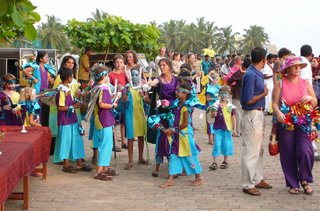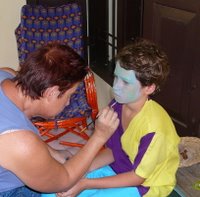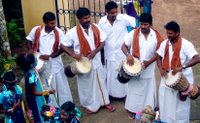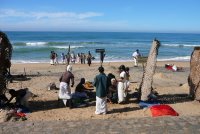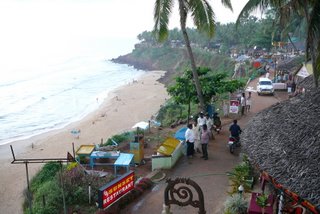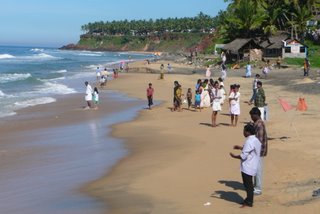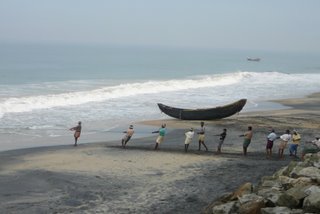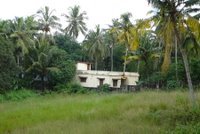
The house we liked the best and which we moved on to was the one I had seen first: We wanted to be away from the honking horns and loud busses on the main road and this place is in a very rural (but not always quiet) location down an almost impassable track, but still is less than a 10 min walk to the beach.
The house was purpose-built to be rented to foreigners so it has the amenities we want, and some surprising features. The building has 3 main rooms, plus a kitchen and a little porch. It
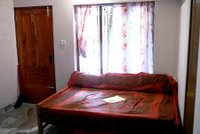
was billed as a 3 bedroom, and there are three beds, but one is in the dining/living room, so we use it as a sofa, and it makes a good guest bed. (Everyone who has said they plan to come and visit, you are welcome to the couch for one week!) Each room has a bathroom with a shower and a sit down toilet, but no toilet paper holders! The kitchen is very clean with marble floors and granite counters, but otherwise was completely empty: a sink with a cold water tap and nothing else! No appliances, no cupboards, nothing.

After some negotiation the owners supplied a two-burner cooker and a fridge, and Santosh (Aunt Jane’s friend) lent us some dishes, so we can prepare cereal, omelettes, sandwiches and tea.
The house is designed to stay reasonably cool. High ceilings with fans and large open windows on two sides of every room let the air circulate. As well, the windows are protected from the sun and rain by a large concrete overhang and each room has a 2 inch slit at the very top to let the hottest air escape. The windows have ornate iron grilles, but no screens so when the glass and curtains are open, they are truly open and any bugs or noises come right in (thank you Dan and Johanne for the mosquito nets).

A well in the side yard provides water, which we have been told is better than bottled water (we still boil just in case) bur we have to remember to switch on a pump every couple of days to fill the roof top tank. There is just one tap at each sink/shower that issues gravity-pressure, luke-warm water, which is really all we need and far more than I had expected for living in rural India.
The electricity is a bit temperamental. We lose power at least once a day for an hour or so, and the plug in the kitchen stopped working after a couple of days. The landlord implied that a good solution was to move the fridge into the living room where there was a working plug, and many Indian families do keep their fridge in the living room, presumably to better show off this sign of prosperity. After some discussion he finally came and fixed the plug. The lighting is harsh: a bare bulb in each room with no obvious way to rig any sort of lamp-shade. Ann has put a reading lamp on our list of things to buy, but there is really nowhere convenient to plug in a lamp.
In many ways we are living in traditional, rural India. We are surrounded by trees, particularly coconut palms, and have an open field on one side. Our neighbours keep cows and their chickens roam into our yard foraging for scraps. We can hear the bleating of sheep or goats nearby and there are crows in the morning and crickets at night so it is never quiet. The smell of wood smoke is always in the air as the neighbourhood women do some of their cooking over
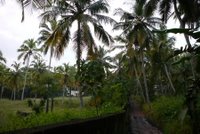
wood fires. This is a fairly prosperous neighbourhood so the more modern sounds of recorded music, television and phones ringing also waft through our open windows. Already we have got to know a few of the neighbours and Rob and Kathleen are over playing with new friends as I write.
An interesting cultural difference is that it seems perfectly acceptable to ask how much one paid for something. Whenever I say I am living in a house, people (this includes our neighbours, rickshaw drivers, waiters in restaurants, the lifeguard at the beach etc) immediately ask how much rent I am pay. So in this spirit of Keralan openness, we pay about CDN$ 265 per month, plus electricity. I think this is about double what an Indian family would pay, but it still seemed reasonable to us.
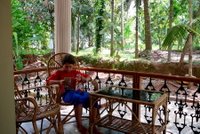
Again I think of how I worried about finding a suitable place for the family to live, and I am so pleased that we seem to have found the perfect mix of Indian culture and western comforts that will make this a memorable home for the next three months.

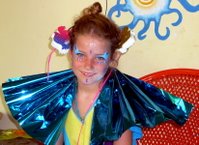 enfants en préparation pour la parade. À 4 hrs, une groupe de 20 enfants et une dizaine d’adultes sont allés au helipad pour attendre le commencement de la parade. Quand la parade a commencé, toute ensemble, nous avons marché le long du sentier de la falaise. Mais soudain, il a commencé à pleuvoir,d’abord nous sommes allés un peu plus vite à Coconut Grove, ou la parade a terminé.
enfants en préparation pour la parade. À 4 hrs, une groupe de 20 enfants et une dizaine d’adultes sont allés au helipad pour attendre le commencement de la parade. Quand la parade a commencé, toute ensemble, nous avons marché le long du sentier de la falaise. Mais soudain, il a commencé à pleuvoir,d’abord nous sommes allés un peu plus vite à Coconut Grove, ou la parade a terminé.